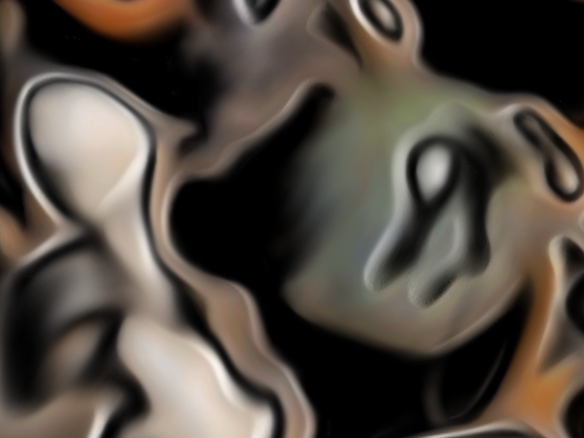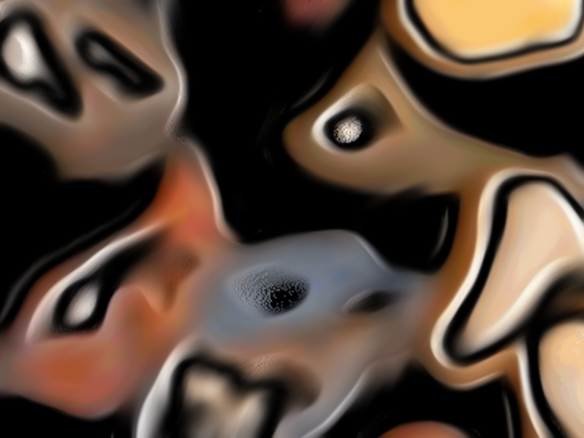001, 2017
002, 2017
003, 2017
004, 2017
007, 2017
012, 2017
017, 2017
022, 2017
Background
I created these painting studies recently using PaintShop Pro and the Procreate painting software for iPad. The forms developed from a combination of two related sources .. impressions received while searching the Thames foreshore, and my collection of used painting palettes.
I feel I might be making some progress in getting more comfortable with working digitally, making the digital manipulation of images actually work for me .. to give me what my mind’s eye wanted .. rather than generating enticing variations which, however interesting, move in other unforeseen and unprepared directions! In traditional image making .. I mean physical painting or drawing, applying real substances onto a physical surface .. there are many limitations in comparison. With continual practise one can extend the range gradually but also become comfortable in working within these limitations, even turning them to advantage. The way one works within limitations defines one’s self .. one’s hand-print, one’s style, one’s visual aesthetic .. with consistency it almost guarantees that what one is doing will be different from another’s. Paradoxically, the infinite range provided by digital image making has led, it seems to me, to a lot of people’s work looking very much the same!
As for the Thames foreshore, I think I’ve written elsewhere that much of the experience is about tuning in to the special ‘otherness’ amongst all the sameness, or looking for the natural or man-made signs of ‘life’ amongst the stones. But the interesting thing is that while doing that I think I’ve acquired a heightened sympathy for it ALL .. the whole range of same, similar, other or distinctive .. because nothing is identical, and everything however simple has a character of its own! In particular, there are the flints with their strong contrasts of dark and light, and their lifeform-like suggestiveness. I have a theory that it was stones such as these, the very same ones around at the dawn of humankind, which assisted the first inklings of the idea that we could both imitate other things and create shapes of our own.
The other aspect of my Thames foreshore experience which seems to be soaking into my work more and more is .. trusting the ready-made, accepting the found object or, in other words, having faith in serendipity .. and this leads in to my second source of inspiration. For some years now I’ve been collecting up the painting palettes used in my courses, letting them dry and scanning them before soaking and scraping them clean. Have you ever stood in front of a ‘non-representational’ painting and been almost literally struck by an overwhelming feeling of ‘rightness’, a feeling .. that the balance is so sensibly poised between harmony and conflict, that the colours are so carefully considered, or that it can suggest a number of ideas but doesn’t need to be any of them? The thing is, on a number of occasions I’ve been hit by a very similar feeling while looking at a used painting palette! Is it possible that a few minutes worth of unfocused paint mixing can inspire the same feelings as weeks of painstaking work? Why not? Isn’t a painting palette a perfect example of form and colour for it’s own sake .. because it can’t be anything else? Isn’t it on the one hand pure and untainted by thought and on the other an honest embodiment of natural forces? When a painter composes an evocative abstraction, i.e. one which elicits agreement on an emotional rather than an intellectual level, aren’t they just painstakingly recreating in their own terms those same instances of rhythm and interruption, sameness and otherness, the individual and the whole, determinism and randomness .. the same that occur in a littered street, a stony foreshore or a painting palette?
While working on these studies I have become very interested again in the questions surrounding abstraction and in particular its relationship with music. This relationship is not about painting that strives to be ‘like’ music, to imitate it, certainly not painting that seeks to evoke musical or auditory sensations. It’s painting that attempts to parallel the way music is experienced.
Why is this so terribly hard? The urge to create paintings that could be experienced like music was introduced into the Fine Art forum about 100 years ago, but that means it’s still a fairly recent notion in the timespan of cultural history. Many recently past or contemporary artists may have evidenced how it could be achieved but that remains only one side of the deal that needs to be struck between creators and public perceptions. It may just be impossible; it may even go against the way we perceive things?
For me the fundamental is ‘Can we appreciate something without feeling the need to recognize what it is, where it comes from or what is meant by it?’ Yes, that’s possible with music! Of course if music appeals to us we become curious about where it comes from, and we may begin to formulate other questions, but those and other thoughts hardly affect its appeal while listening to it .. and I’m sure that most people would agree that the question ‘what is meant by it’ is unlikely to be in their minds while enjoying it? It does its job without the need for meaning! To put it another way, music can work on us without the need to reference anything other than itself.
Why can’t we do that with painting? For the moment I’m fairly convinced that we can’t .. but I don’t know why yet. Is it simply because vision is our primary means of reading, interpreting or in other words ‘making sense’ of our world, so we just can’t let go of that basic directive when it comes to processing anything visual? Or is it linked to the very different way we receive the two i.e. music can only ever be one note at a time, as it were, whereas a painting is commonly taken in all at once, then re-examined in detail? So the brain has to process the input in a different way? In a sense, music is never there, it can’t be ‘frozen’, our perception of it is a combination of the memory of what has been and the anticipation of what is to come. Maybe it’s just this disembodiment which is the key to understanding why music can work on us so ‘abstractly’ whereas painting cannot?





Super!!
I have so many comments to make in response to your post. I’ll do this by using quoted pieces of your text.
“Paradoxically, the infinite range provided by digital image making has led, it seems to me, to a lot of people’s work looking very much the same!”
Yes, the key to making personal artistic expression using digital images would be to imbue the work with your own ‘personality’. As you put it, “To give me what my mind’s eye wanted”. And your ‘mind’s eye’ is not founded on some automated response or other people’s previous artistic expressions.
Regarding your insights from the Thames foreshore:
“…. nothing is identical, and everything however simple has a character of its own!
It is desirable then to imbue the images with a sense of the ‘unique essence’ of each form. Technique comes into play here and your palettes have served you well.
I found the above images exuding a sense of organic character regardless to whether the images were non-definable amorphous blobs or seemingly abstracted realistic forms. For instance 012/2017 LHS image looks to me like bird with an exposed encased egg…each viewer can read into it what they will…it is a evocative image.
I have more to say and will continue in a few days when I have more time.
Hello Tina,
Thanks for your comments! Yes, I wanted to get a sense of ‘organic’ but not much more than one step up from a ‘lava lamp’. The bird was intentionally encouraged to form a little more but I didn’t see that the wing could also be an egg! Thanks for that!
best, David
Thanks for your post, David and your question: ‘Can we appreciate something without feeling the need to recognise what it is, where it comes from or what is meant by it?’ I think music is so powerful and is ‘felt’ differently to Art because it has been around for millennia as a group form of expression/ritual and story-telling. We feel the vibrations and they literally move our bodies. Music reaches something deep and ancestral within us (whether thats emergent music, atonal, discordant music, Baroque or Contemporary etc etc) – it is somehow familiar even when it is ‘new’. We will each have a response to music because it ‘means’ something to us. It elicits a response in each listener (willing or otherwise). That could be joy, sadness, revulsion or anger for example. It is evanescent and yet we can be ‘nostalgic’ for those sounds of our childhood – our Mothers’ voices perhaps. It is, simply, immersive (the sound bathes us). I think Art has to evolve further before it can have that effect on the masses. For now Art must be satisfied with the individuals that experience it and who are, perhaps, interested. It is not often that Art moves the souls of a gallery’s collective audience. Music however can do that and does so, often. Music is ‘huge’ like that…and yet can be incredibly small and intimate.
Thanks Helen,
Yes I agree .. and you’ve given me some other things to think about! I feel that visual art will most probably always remain more ‘informational’ than emotional.
best, David